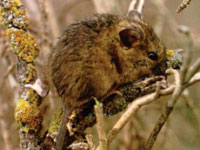Salt Marsh Harvest Mouse
| Salt marsh harvest mouse | |
|---|---|
 |
|
| Scientific classification | |
| Kingdom: | Animalia |
| Phylum: | Chordata |
| Class: | Mammalia |
| Order: | Rodentia |
| Family: | Cricetidae |
| Subfamily: | Neotominae |
| Genus: | Reithrodontomys |
| Species: | R. raviventris |
| Binomial name | |
|
Reithrodontomys raviventris Dixon, 1908 |
|
The salt marsh harvest mouse (Reithrodontomys raviventris), also known as the red-bellied harvest mouse and sometimes called the saltmarsh harvest mouse, is an endangered rodent endemic to the San Francisco Bay Area salt marshes in California. There are two distinct subspecies, both endangered and listed together on federal and state endangered species lists. The northern subspecies (Reithrodontomys raviventris halicoetes) is lighter in color and inhabits the northern marshes of the bay, and the southern subspecies (Reithrodontomys raviventris raviventris) lives in the East and South Bay marshes. They are both quite similar in appearance to their congener species, the [Western harvest mouse, R. megalotis], to which they are not closely related. Genetic studies of the northern subspecies have revealed that the salt marsh harvest mouse is most closely related to the plains harvest mouse, R. montanus, (), which occurs now in the Midwest]. Its endangered designation is due to its limited range, historic decline in population and continuing threat of habitat loss due to development encroachment at the perimeter of San Francisco Bay.
The southern population of the salt marsh harvest mouse tends to have dark brown fur above and a pinkish cinnamon or tawny belly; moreover, the tail is likewise bicolored. An adult's length is five to seven centimeters (2 to 3 inches) and a tail length of six to ten centimeters (2 to 4 inches). The height is between 1.5 and 2.1 centimeters (0.6 to 0.8 inches). Weight of a mature mouse is approximately 10 to 20 grams (0.35 to 0.7 ounces). The northern subspecies is also dorsally brown or reddish brown, but the venters tend to be white or cream, and rarely with a hint of reddish; tail length is usually about 120% of the body length. The upper incisors are grooved.
This species is nocturnal, with particularly noted activity on moonlit nights. This mouse is particularly resourceful, making use of ground runways of other rodents; moreover, he also exhibits climbing agility. It occupies marsh habitats where pickleweed and marsh plants abound. Its many predators feature hawk, snake and owl species, as well as shorebirds and larger mammals. Predation by domestic cats is an issue due to encroachment of the limited habitat by humans at the perimeter of the San Francisco Bay.
...
Wikipedia

